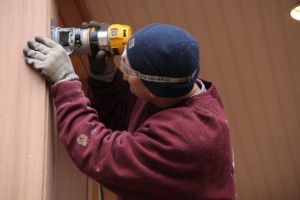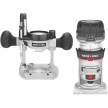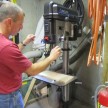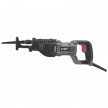Job Site Routers
Job Site Routers For The Carpenter:
As a renovation carpenter that often finds myself dealing with rotted window sills on Monday and installing a built in bookcase on Tuesday I have a myriad of tools and have to be prepared for anything.
Part of that tool arsenal is my job site routers. I have routers that never leave my workshop for intricate and production style work and I have routers that are specifically designated for the job site. These are the true unsung hero’s on the job site.
When I think about job site routers I try to think about the tasks that I really need them for. Projects such as easing edges on decking and trim, creating champers, installing built –ins, window sills and making on the spot moldings are on top of my list.
Job Site Routers:
At the job site I have two routers, both happen to be Porter Cable routers. One is fixed to a small router table and used to run long length of trim fast and accurately, the other is a PC450 compact router.
Compact or Trim routers are more and more popular on the job site these days. With motors sized at 1 HP or less compact routers are set up for 1/4 inch collet router bits and used for light duty work Their small size and light weight makes them very easy to use by hand but have insufficient power to be used in a router table.
What To Look For In A Job Site Router
A fixed-base router consists of little more than a motor, a base and a couple of handles. It’s important to pay attention to how the cutting depth is adjusted. some routers are difficult to adjust and others do it nicely.
Spring-loaded plunge bases are more complicated to adjust. These tools have an adjustable depth stop, and most incorporate a rotating turret with several steps, so you can make cuts at different depths. All models have a plunge-lock lever for locking the motor in the base while cutting.
If your budget only affords you one router I’d start off with a mid sized router with 1-3/4 HP, especially if you do most of your routing applications on a job site. The compact routers are outstanding but limited to light duty routing applications and the 3HP routers are heavy and best suited mounted to a table.
Power:
You want a router that will support what you need to do. A high-speed, low-torque router will make the smoothest cuts. In my opinion a 1-3/4 HP motor delivers the power to meet the toughest job site applications and a 3.0 HP motor is best for a workshop permanently mounted dedicated router table for more production work and larger bits. One nice feature to look for is a soft starting motor which means the motor speeds up gradually and will ultimately prolong the life of the motor.
Comfort:
Ergonomics is huge for a hand held router. The compact routers offer hand held capability and look and feel like an over sized laminate trimmer. They are also light weight andcomfortable to use, easily allowing one-handed operation. Holding a compact router at shoulder height or higher to router out a top hinge in a door jamb is easier than ever.
D-Handle routers are also a favorite or mine. The D-Handle offers the operator way more control and is also very comfortable for the hand, wrist and elbow and puts the trigger right where you want it.
Many people over look the location of the power switch. Hold the router as if you were using it and seed how easy it is to turn on and off.
Adjustments:
Fixed or plunge bases offer different advantages and you should have both options available to you on the job site. Most plunge routers allow for a four position turret style depth stop and easy access plunge lock which is a huge plus when starting and stopping a dado or plunge cut.
My Porter Cable plunge base provides a full 2 plunge distance which is also nice to have. Fixed base routers typically feature an adjustment ring and clamp for controlled bit depth and allows the operator to make changes to within 1/64
My Porter-Cable’s D-Handle, fixed base 691 allows for micro depth adjustments for bit depth changes accurate to 1/128 of an inch and it accepts collets for 1/4 and 1/2 inch shank router bits.
Capacity:
There are some differences and advantages to each. A 1/2″ router bit shank is bigger and has more mass than the 1/4″ shank bits. The larger shank bits translate into less “chatter,” or vibrations caused by the high speed of the spinning bit.
It’s been proven that larger bits cut cleaner, dissipate heat faster, provides the router collet with more surface area to grip and less risk of slippage and offers the user more options such as larger size bits and ball bearing guide options.
Most mid-sized routers come with both 1/4″ and 1/2″ collets which will allow you to expand the routers use and provide more router bit versatility to you on the job site.
Accessories:
Bases: Some routers come with a fixed and plunge base which give you a ton of more options, it’s like having two routers in one. A fixed base is ideal for template work and for beading. A plunge base router allows the motor to move up and down along two guides. With the motor locked on the base a level lock controls the depth of the bit.
The main advantage of a plunge router over a fixed base is it allows the motor to come up to speed before making a cut. The bit can be lowered into the stock allowing cuts to be made that are in the center of the stock. Cuts like mortises and dadoes are best performed with a plunge router since the bit can be raised out of the cut once you reach a stopping point.
Base Plates: Look for a large hole in the base to accommodate medium to large bits. A minimum of 3-inches is a must with 4-inches being better.
Variable Speed: Having a variable speed control to reduce the RPM’s of the router bit is extremely useful and necessary with different size router bits and especially if you are using a router table. The more wood you are removing, the slower the bit should rotate.
Dust Control: Routers make a ton of saw dust and connecting your router to a vacuum is a good decision. I do not usually take the time to do this outdoors but have on interior trim projects and it makes a huge difference with clean up. Customers notice too! In my shop I have a dedicated dust collection hose connected to my workshop router table. In the shop it’s a must!
More and more manufacturers are offering dust collection as a standard accessory it’s a nice option to have.
Which Job Site Routers Do I Use?
I have about five routers and use them all for different applications. For job site routers, I recommend having two. One mounted in your portable router table and one for portable use. I use the following two PorterCable routers:
PorterCable 1.25HP Compact Router Fixed/Plunge Combo Kit 450PK
The 450PK includes Motor, Standard Base, Plunge Base, Wrench, Instruction Manual, Carry Bag.
PorterCable 450PK Features:
- Compact, lightweight design
- 1.25HP motor
- Soft-starting motor
- Adjustment ring allows bit depth changes to within 1/64″
- Large, low-pressure spindle lock button allows single wrench bit changes
- Multiple shaft-lock detents enables easy bit changes
- Depth ring and clamping mechanism combine to ensure motor remains locked in position
- Plunge base incorporates fine-tune adjustment rod for depth setting
- 5-position adjustable turret enables stepped or repeated plunge cuts
- Up to 1.5″ of depth travel with standard base and 2″ with plunge base
- Over molded rubber handle (plunge base only)
- Durable aluminum motor housing and base construction
- Large 4″ diameter sub-base accepts universal template guides (fixed base only)
- Large plunge base platform provides added stability for heavier applications and sub-base accepts universal template guides
- Extended 8-slot 1/4″ collet maximizes surface contact with router bit shank for a tighter grip
PorterCable 691 11 Amp 1-3/4-Horsepower D-Handle Router
PorterCable’s D-Handle, fixed base 691 1-1/2 HP, 27,500 RPM router is ideal for job site. It’s the most powerful router I have in my tool trailer and on the job site. If I need more power I perform the routing application in my shop on my 3 HP router.
Typically this is the router that I mount in my Titan portable router table. I have a fixed base installed on the router table and usually leave it on the router table for job site faster set up and tear down.
The best feature of this router besides it outstanding reputation and years of trusted, reliable service is the D-Handle design. The D-Handle allows for a low center of gravity and allows the router to be easily controlled. The trigger is located right at the D-Handle, a perfect location, so there is no searching or reaching for the on or off switch. A lock on feature prevents trigger finger fatigue.
A micro depth adjustment allows for bit depth changes accurate to 1/128 of an inch. It accepts collets for 1/4 and 1/2 inch shank bits and features an auto-release collet system minimizing frozen bits.
PorterCable 691 Features
- 11 Amp, 27,500 rpm motor producing 1-3/4 Peak HP
- GripVac™ handle allows for both single hand gripping and enhanced router control when used in conjunction with standard knob
- D-handle incorporates trigger switch with “lock-on” feature
- Precision machined aluminum motor housing and base
- Micrometer depth adjuster accurate to 1/128″
- Dust-sealed switch and sealed ball bearing construction enhance tool durability
- Auto-release collet system allows for easy bit removal after use
- Collets included to accept 1/4″ and 1/2″ shank bits










